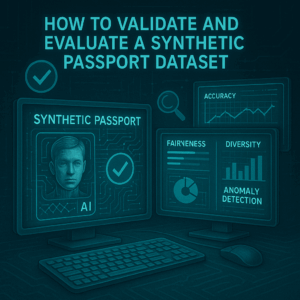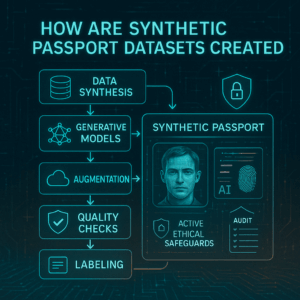In the modern digital landscape, the demand for fast, secure, and accurate identity verification systems is at an all-time high. From opening a new bank account online to clearing customs at an airport, the ability to verify a person’s identity based on their passport is a critical function.
However, the development of the AI models that power these systems faces a major hurdle: a lack of sufficient, real-world data due to stringent privacy laws and ethical concerns. This is where synthetic passport datasets come in.
A synthetic passport dataset is a collection of artificially generated, yet highly realistic, passport images and associated data. Created using advanced generative AI techniques, these datasets mimic the appearance and statistical properties of real passports without containing any genuine personally identifiable information (PII). This article explores the transformative applications of synthetic passport datasets across various industries, highlighting how they are solving real-world problems and paving the way for a more secure and efficient future.

1. Enhancing Fraud Detection and Prevention in Financial Services
The financial services sector is a prime target for identity fraud, particularly with the rise of synthetic identity fraud where criminals create a fake persona to obtain credit and loans. Financial institutions are increasingly relying on AI to combat these threats, and synthetic passport datasets are a key tool in this fight.
- Training Robust Fraud Detection Models: Real-world fraud data is inherently rare and sensitive. By using synthetic passport datasets, financial institutions can create a virtually unlimited supply of forged or manipulated documents to train their AI models. The datasets can be designed to include a wide range of forged document types, from simple photo swaps to sophisticated forgeries that are difficult for even human eyes to detect. This allows the AI to learn and identify subtle patterns and anomalies that indicate a fraudulent document.
- Stress-Testing Verification Systems: Before a new identity verification system is deployed, it must be rigorously tested to ensure it can withstand sophisticated attacks. Synthetic datasets provide a safe environment for this stress-testing, allowing banks to simulate various fraud scenarios without risking real data.
- Reducing False Positives: By training on a diverse and comprehensive synthetic dataset, the AI model can learn to distinguish between genuine, but unusual, documents and fraudulent ones, thereby reducing the number of false positives. This improves the customer experience by minimizing unnecessary rejections and delays.
| Application in Finance | Role of Synthetic Passport Datasets | Benefit |
| Account Opening | Simulating fraudulent document submissions to train real-time verification algorithms. | Reduces onboarding fraud and secures new customer acquisition channels. |
| KYC (Know Your Customer) | Creating datasets with known vulnerabilities to test the resilience of KYC processes. | Ensures compliance with regulations and prevents financial crime. |
| Biometric Authentication | Generating diverse facial images to train biometric systems that can detect “liveness” and prevent spoofing. | Enhances security for app logins and high-value transactions. |
Export to Sheets
2. Revolutionizing Border Security and Travel
Border control agencies and airports are under pressure to process travelers quickly while maintaining a high level of security. AI-powered systems are crucial for achieving this balance, and synthetic passport datasets are an indispensable resource for their development.
- Automated Document Verification: AI models trained on synthetic data can instantly scan and verify passports, checking for authenticity indicators and comparing the passport photo to the traveler’s face. This accelerates the verification process, reduces wait times, and allows agents to focus on more complex cases.
- Advanced Forgery Detection: Synthetic datasets can be custom-made to include specific forgery types, such as manipulated machine-readable zones (MRZs) or tampered holographic overlays. This enables AI systems to detect sophisticated forgeries that may be missed by human agents, thereby strengthening national security.
- Cross-Border Data Sharing (Safely): In the future, synthetic data could facilitate secure data-sharing between international security agencies. Instead of sharing sensitive real-world data, agencies could share synthetic datasets to improve their respective AI models, allowing for better collaboration in a privacy-preserving manner.
3. Improving Biometric Systems and Facial Recognition
Facial recognition is a core component of modern identity verification. The accuracy and fairness of these systems are paramount, and synthetic data is a key to achieving both.
- Minimizing Algorithmic Bias: A significant challenge with facial recognition is algorithmic bias, where models perform less accurately for certain demographics (e.g., people with darker skin tones, or specific ethnic groups) due to an underrepresentation of these groups in the training data. Synthetic datasets can be generated to be demographically balanced, ensuring the model is trained on a fair and diverse range of faces, leading to more equitable performance for all users.
- Training for “Liveness Detection”: Synthetic datasets can be used to train AI models to detect “liveness”—the ability to distinguish a real person from a photograph, video, or deepfake. The datasets can include thousands of images and videos of spoofing attempts, such as printed photos, videos on a phone screen, and even 3D masks, making the AI system highly effective at preventing these attacks.
- Enhancing Performance with “Hard Negatives”: In facial recognition, “hard negatives” are facial images that are difficult for the model to distinguish. By using synthetic data to generate these challenging examples (e.g., twins, people with similar features), developers can train a model to be more precise and reduce the likelihood of misidentification.
4. Other Key Applications and Related Concepts
The utility of synthetic passport datasets extends beyond the most obvious use cases. They are also being leveraged in several other domains.
- Data Augmentation: For organizations with existing, small datasets of real passports, synthetic data can be used to “augment” or expand the dataset. This process involves generating new images that are similar to the real ones but with variations in lighting, angles, and facial expressions, which helps to improve the robustness of the model.
- Software Development and QA: Developers can use synthetic datasets to test and debug software related to identity verification without worrying about data breaches or privacy violations. This accelerates the development cycle and allows for more thorough testing.
- Academic Research: Researchers can use synthetic datasets to develop and publish new AI algorithms without the legal complexities of using real PII. This fosters innovation and collaboration in the academic community.
The Future of Synthetic Data in Security
The applications of synthetic passport datasets are just the beginning. As generative AI technology advances, the quality and realism of synthetic data will only improve, leading to even more sophisticated and accurate AI models. The future of digital security and identity verification is deeply intertwined with the development of synthetic data. By prioritizing privacy, fairness, and security, synthetic datasets are poised to become the cornerstone of AI model development in a world where digital identities are increasingly important. This shift is not just about making AI development easier; it’s about building a more secure, inclusive, and trustworthy digital world for everyone.
Related Concepts and Topics
- synthetic data generation
- Generative AI
- machine learning training
- computer vision
- algorithmic bias
- data privacy
- GDPR compliance
- digital identity
- document analysis
- biometric authentication
- liveness detection
- fraud prevention
- cybersecurity
- deepfake detection
- financial technology (FinTech)
FAQs
They are used to train AI models for ID verification, fraud detection, and document recognition.
They provide realistic test cases for verifying liveness detection and anti-spoofing measures.
Yes, they are often applied in training convolutional neural networks (CNNs) and GAN-based models.
Yes, they are used in controlled environments to strengthen identity verification systems.
They will play a growing role in fighting identity fraud by providing scalable, privacy-friendly training data.


